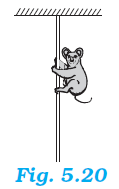Laws of Motion
Question
A monkey of mass 40 kg climbs on a rope (Fig. 5.20) which can stand a maximum tension of 600 N. In which of the following cases will the rope break: the monkey
(a) climbs up with an acceleration of 6 m s–2
(b) climbs down with an acceleration of 4 m s–2
(c) climbs up with a uniform speed of 5 m s–1
(d) falls down the rope nearly freely under gravity?
(Ignore the mass of the rope).

Answer
Case (a):
Mass of the monkey, m = 40 kgAcceleration due to gravity, g = 10 m/s
Maximum tension that the rope can bear, Tmax = 600 N
Acceleration of the monkey, a = 6 m/s2 , upward
Using Newton’s second law of motion, equation of motion is
T – mg = ma
∴ T = m(g + a)
= 40 (10 + 6)
= 640 N
Since T > Tmax, the rope will break in this case.
Case (b)
Acceleration of the monkey, a = 4 m/s2 downward
Using Newton’s second law of motion, the equation of motion is,
mg – T = ma
∴ T = m (g – a)
= 40(10 – 4)
= 240 N
Since T < Tmax, the rope will not break in this case.
Case (c)
The monkey is climbing with a uniform speed of 5 m/s.
Therefore, its acceleration is zero, i.e., a = 0.
Using Newton’s second law of motion, equation of motion is,
T – mg = ma
T – mg = 0
∴ T = mg
= 40 × 10
= 400 N
Since T < Tmax, the rope will not break in this case.
Case (d)
When the monkey falls freely under gravity, acceleration will become equal to the acceleration due to gravity, i.e., a = g
Using Newton’s second law of motion, we can write the equation of motion as:
mg – T = mg
∴ T = m(g – g) = 0
Since T < Tmax, the rope will not break in this case.
Sponsor Area
Some More Questions From Laws of Motion Chapter
Which law of motion is also called law of inertia?
What is measure of inertia of body?
Which law of motion defines the force?
What happens to a stone tied to the end of string and whirled in a circle if the string suddenly breaks?
Which law of motion gives the quantitative knowledge of force?
Which law of motion is the real law of motion?
Which law of motion gives the quantitative definition of force?
Why do we pull the rope in downward direction for climbing up?
What can set the body at rest into motion?
What do you mean by mechanically isolated system?
Mock Test Series
Sponsor Area
NCERT Book Store
NCERT Sample Papers
Sponsor Area